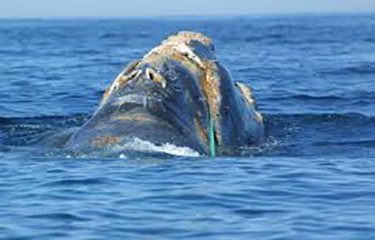The Maine Department of Marine Resource has submitted a proposal for regulatory changes to the state’s lobster industry intended to help protect the highly endangered North Atlantic right whale to the National Marine Fisheries Service (NMFS) in advance of federal rule making on the issue.
The proposal comes after the department held 10 public meetings with members of the lobster industry, and performed further analysis of available data to determine how to balance the needs of the industry and the need to protect the endangered species. The new proposal counters the earlier one by the NMFS’ Take Reduction Team (TRT), which made the recommendation that the entire industry attempt to reduce its vertical lines by 50 percent back in April 2019.
Lobstermen and the industry have been pushing back against the TRT’s proposal for months. The Maine DMR, upon examining the impacts and benefits of the TRT’s recommendations, found that it “placed the largest burden on in-shore waters where whales rarely venture,” according to a release from the department.
According to Maine DMR’s Director of Communications Jeff Nichols, the department worked hard to find a solution that took industry concerns into account while still protecting right whales.
“We were able to develop our own analysis of risk, and we incorporated that with feedback of industry,” Nichols told SeafoodSource. “Our plan was based on the DMR doing a deep dive into the data, incorporating some data that we were able to develop through survey and survey of industry, and studies of rope.”
What the DMR’s study found was that the majority of rope used in the lobster industry is of a smaller diameter than the rope typically found on right whales that have suffered entanglement-related deaths. In addition to that, a large portion of the vertical lines used by the industry are situated in areas near to the shore, where the whales rarely, if ever, venture.
“We feel confident that the analysis we did of the data, and the critical input and support from the industry, resulted in a plan that will not only protect whales, but it will also protect the interests of the industry,” Nichols said.
The proposal includes exemptions in vertical line restrictions for the near-shore fishery based on the “Maine exemption line,” which encompasses 70 percent of the state’s waters. From the shore to that exemption line, which is a varying distance from the shore but typically sits within three miles, there won’t be any restrictions on vertical lines.
Regulations start to increase the further from shore traps are placed. From the exempted line, to the three-mile line, a minimum trawl length of three traps per single endline is established. The requirements steadily increase, requiring more traps per endline, up to the 12-mile-plus area, where a minimum of a 25-trap trawl with two endlines is established.
In addition, in state waters a single 1,700-pound weak point will be required halfway down all vertical lines in the lobster fishery. From three miles out to 12 miles, two 1,700-pound weak points are required. Then, lines beyond 12 miles from shore require one 1,700-pound weak point one-third of the way down the line.
In addition to those requirements, Maine gear will now also be marked with a new, Maine-only marking that is required at the top, middle, and bottom of all vertical lines. All lobster license holders will also start being required to report their landings. Currently, just 10 percent of license-holders are required to complete harvester reporting, which provides estimates of the catch.
All of the new requirements, Nichols said, are designed to protect whales where the whales are typically traveling, while balancing that against the needs of the industry.
The Maine Lobstermen Association, however, is still skeptical of every proposal made so far that places restrictions on the industry in order to preserve the Northern right whale population.
"The MLA remains concerned that Maine lobstermen are being asked to do more than our share to protect right whales," MLA Executive Director Patrice McCarron told SeafoodSource. "Consider the facts. There were nine right whale deaths in Canada in 2019 and a tenth found in the U.S. that was likely from Canadian fishing gear. In the U.S., there are no plans underway to address ship strikes or risks from other U.S. fisheries. According to NMFS data, entanglement rates in lobster gear declined by 90 percent since implementation of whale rules in 2010. The MLA cannot support any plan that attempts to reverse the right whale decline on the backs of U.S. lobstermen while ignoring other known threats."
Regardless of support from the industry, the Maine DMR plan still needs approval from the NMFS before any regulations can move forward.
“At this point, we wait for word back from NMFS as to whether or not they’ll accept this plan, or modify it, or what,” Nichols said. He added the department expects the rulemaking process to take place this spring or summer.
Photo courtesy of NOAA







